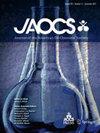Impact of extraction conditions and seed variety on the characteristics of pennycress (Thlaspi arvense) protein: a structure and function approach
IF 1.9
4区 农林科学
Q3 CHEMISTRY, APPLIED
引用次数: 0
Abstract
As the consumer demand for plant proteins continues to grow, the food industry is seeking novel and sustainable protein sources to incorporate in various food products. Pennycress (Thlaspi arvense), a sustainable cover crop, produces oilseeds high in protein, warranting investigation. Accordingly, protein extraction from pennycress was evaluated under various extraction conditions, using alkaline extraction and salt solubilization coupled with ultrafiltration. Given the superior color and functionality of the salt extracted pennycress protein isolate (PcPI), its production was scaled‐up about two hundred folds in a pilot plant. Furthermore, a new pennycress accession bred to have zero erucic acid (0EA) was evaluated to determine the impact of seed variety on protein characteristics. Structural and functional characterization was performed on PcPI and compared to native (nSPI) and commercial (cSPI) soy protein isolates. Salt extracted PcPI had comparable gel strength to cSPI, three times higher solubility under acidic conditions, and ~1.5 times better emulsification capacity. PcPI extracted from 0EA was mildly different in structure and functionality from that extracted from wildtype pennycress, with the slight variation attributed to genetic variance. Finally, the protein digestibility‐corrected amino acid score (PDCAAS) of the salt extracted PcPI, calculated in vivo (0.72) and in vitro (0.87), was superior or comparable to other plant protein sources. This research provided, for the first time, a comprehensive evaluation of different protein extraction protocols to produce a functional PcPI that can compete with soy protein for various food applications, such as acidic beverages, meat and dairy products, and emulsified systems.提取条件和种子品种对pennyapress (Thlaspi arvense)蛋白特性的影响:结构和功能研究
随着消费者对植物蛋白的需求不断增长,食品工业正在寻求新的和可持续的蛋白质来源,以纳入各种食品。pennycrese (Thlaspi arvense)是一种可持续的覆盖作物,其生产的油籽富含蛋白质,值得研究。在不同的提取条件下,采用碱性提取、盐增溶+超滤的方法对pennygrass蛋白的提取效果进行了研究。由于盐提pennyress protein isolate (PcPI)具有优越的颜色和功能,其产量在中试工厂中扩大了约200倍。此外,还对零芥酸(0EA)的pennycrea新品种进行了评价,以确定种子品种对蛋白质特性的影响。对PcPI进行了结构和功能表征,并与天然(nSPI)和商业(cSPI)大豆蛋白分离物进行了比较。盐提PcPI的凝胶强度与cSPI相当,在酸性条件下的溶解度是cSPI的3倍,乳化能力是cSPI的1.5倍。从0EA中提取的PcPI在结构和功能上与野生型pennycrea中提取的PcPI略有不同,这种差异归因于遗传变异。最后,盐提取的PcPI的蛋白质消化率校正氨基酸评分(PDCAAS),在体内(0.72)和体外(0.87)计算,优于或与其他植物蛋白来源相当。这项研究首次对不同的蛋白质提取方案进行了全面的评估,以产生一种功能性的pci,可以在各种食品应用中与大豆蛋白竞争,如酸性饮料、肉类和乳制品以及乳化系统。
本文章由计算机程序翻译,如有差异,请以英文原文为准。
求助全文
约1分钟内获得全文
求助全文
来源期刊
CiteScore
4.10
自引率
5.00%
发文量
95
审稿时长
2.4 months
期刊介绍:
The Journal of the American Oil Chemists’ Society (JAOCS) is an international peer-reviewed journal that publishes significant original scientific research and technological advances on fats, oils, oilseed proteins, and related materials through original research articles, invited reviews, short communications, and letters to the editor. We seek to publish reports that will significantly advance scientific understanding through hypothesis driven research, innovations, and important new information pertaining to analysis, properties, processing, products, and applications of these food and industrial resources. Breakthroughs in food science and technology, biotechnology (including genomics, biomechanisms, biocatalysis and bioprocessing), and industrial products and applications are particularly appropriate.
JAOCS also considers reports on the lipid composition of new, unique, and traditional sources of lipids that definitively address a research hypothesis and advances scientific understanding. However, the genus and species of the source must be verified by appropriate means of classification. In addition, the GPS location of the harvested materials and seed or vegetative samples should be deposited in an accredited germplasm repository. Compositional data suitable for Original Research Articles must embody replicated estimate of tissue constituents, such as oil, protein, carbohydrate, fatty acid, phospholipid, tocopherol, sterol, and carotenoid compositions. Other components unique to the specific plant or animal source may be reported. Furthermore, lipid composition papers should incorporate elements of yeartoyear, environmental, and/ or cultivar variations through use of appropriate statistical analyses.

 求助内容:
求助内容: 应助结果提醒方式:
应助结果提醒方式:


